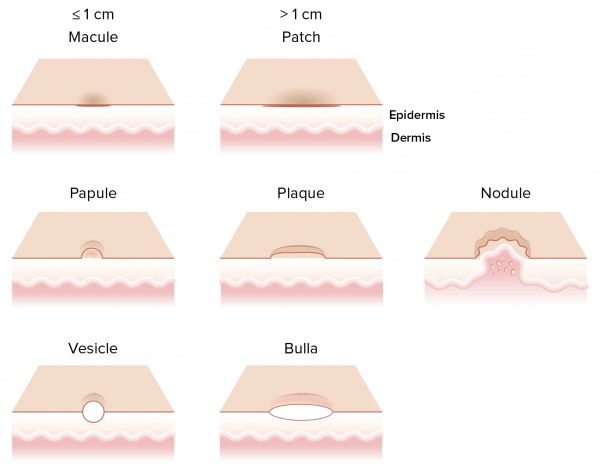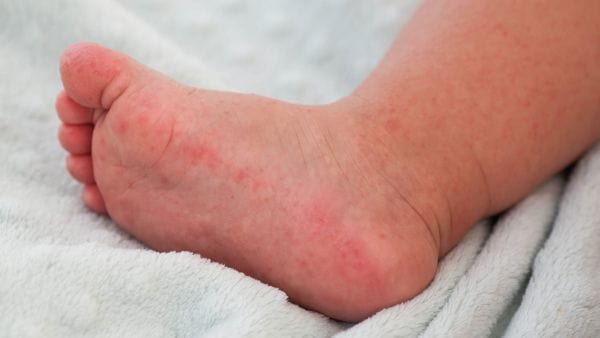Friction blisters are a common problem for people who are active. They’re also common for some people when they get new shoes. But not all blisters are friction blisters. There are many other types and causes of blisters on feet. By the way, the dermatological term for blister is bulla (bullous). But as you can see from the image below, bulla look a lot like vesicles, papules and plaques. So be prepared for these terms in the discussion below where there are links to click through to understand more about the signs, symptoms, causes and treatments.

Primary skin lesions
Types and Causes of Foot Blisters
Friction blisters
Firstly, friction blisters can progress to blood blisters if there is deeper injury leading to blood mixing with blister fluid. They may be red, purple, or black.Blood blisters
Blood blisters can also occur when the skin is under pressure or pinched, but doesn't break, often near bony prominences. Learn more here.Chickenpox (Varicella)
Chickenpox is a highly contagious viral infection that causes an acute fever and blistered rash, mainly in children, usually before the age of ten. In children, chickenpox usually begins as itchy red papules progressing to vesicles on the stomach, back and face, and then spreading to other parts of the body. Chickenpox is usually more severe in adults. Most adults who get chickenpox experience symptoms for up to 48 hours before breaking out in the rash. These include fever, malaise, headache, loss of appetite and abdominal pain.Learn more here.
Hand, foot and mouth disease (HFMD or HFM)

Hand, foot and mouth disease - image credit
Hand, foot, and mouth disease is a viral illness characterized by a blister-like rash on the hands, feet, and inside the mouth. It mainly affects children under 10 years of age, with 95% of the cases occurring under 5 years of age. However, it can also affect older children/adolescents. Adults, especially those who are immunocompromised, may also be affected. The illness usually begins with one or all of the following: fever, sore throat, loss of appetite, and lethargy. However, many children remain well in themselves despite the rash. The blisters usually appear 1–2 days following the fever. The incubation period is typically 3–6 days and children remain infectious until the blisters have ruptured and healed (usually 7–10 days).Learn more here.
Herpes zoster (Shingles)
Herpes zoster is a localised, blistering and painful rash caused by the reactivation of varicella-zoster virus (VZV). Zoster can occur in childhood but is much more common in adults, especially older people. People with various kinds of cancer have a 40% increased risk of developing zoster. Those who have had zoster rarely get it again; the chance of getting a second episode is about 1%. The clinical presentation of herpes zoster depends on the age and health of the patient and which dermatome is affected. Learn more here.Tinea
Also known as athlete’s foot, tinea is a very common fungal foot problem and often appears as small itchy foot blisters. Under the arch of the foot and between the toes are common areas. Tinea is also common because it’s easy to spread. Athletes are especially vulnerable as the dark, warm, moist in-shoe environment is the perfect breeding ground for a fungal infection. Learn more here.Ant bites/stings
The typical reaction to many ant bites/stings is a localised urticaria (a raised itchy rash, also known as hives, weals or welts). A fire ant bite or sting causes immediate pain and a red spot, followed a few hours later by a tender, itchy pustule that can last several days to weeks. It is common for bites to be clustered especially under clothing. Learn more here.Spider bite
Spider bite sites usually look swollen and red. The venom produced by spider bites is generally either neurotoxic or cytotoxic. Web dwellers tend to have neurotoxic venom and non-web dwellers cytotoxic venom. Signs and symptoms from a bite from a spider with neurotoxic venom usually start about 1-3 hours after being bitten. Some signs and symptoms are: severe pain in the chest and abdomen (cramp-like pains), breathing difficulties, heart palpitations. Whereas a bite from a spider with neurotoxic venom is painless but symptoms develop 2-8 hours later and affects cellular tissue and is usually restricted to the area of the bite. Eventually, a blister may form which then sloughs to create an ulcerated wound (up to 10cm). This is an interesting read about the dreaded white-tail spider bites. Learn more here.Other bites and stings
Jellyfish stings can cause skin irritation, pain, and blistering. The sting site may appear red, swollen, and painful, with small blisters or raised welts. Arthropods like centipedes and mites can bite or sting. A venomous sting from a bee or wasp will cause a painful stinging sensation with redness and swelling of the area followed by the formation of a welt or papule that may become itchy. Sensitisation to the venom affects response. A large localised reaction causes swelling to spread more widely over several hours. Learn more here.Burn blisters
You'll hopefully be well aware you've sustained a burn. But not everyone feels pain. When it comes to burns that cause blisters, they go a little deeper than friction blisters and need a little more care. They're actually second-degree burns. Learn more here.Sunburn
Sunburn is erythema (redness) and oedema (swelling) from excessive exposure to the sun’s rays, more specifically the ultraviolet (UV) radiation emitted from the sun or even a solarium. Regions situated closer to the equator, skin exposure between 10 am - 2 pm (65% of UV radiation reaches the earth between these times, and environmental reflection (UV radiation is 80% reflected by snow and ice) are just some of the factors that increase the incidence of sunburn. So, don’t forget to cover your feet in sunblock if they are going to be exposed. Signs and symptoms usually occur 2-6 hours after exposure and peak at 12-24 hours; they may include redness, swelling, blistering, tenderness and irritation and pain, followed by peeling skin. Learn more here.Frostbite
Extreme cold exposure to the feet can cause blood vessels to constrict to the point that skin and underlying tissue die. Blisters are a feature of both stage 1, 2 and 3 frostbite. Medical attention is required to ensure effective rewarming of the effected part without inflicting further and irreversible damage. Learn more here.Cryotherapy
Cryotherapy is a common treatment for skin lesions including superficial skin cancers and verrucae (warts). It involves applying liquid nitrogen for around 30 seconds to the skin with the intention of destroying tissue. A blister usually results at the site of application. Learn more here.Dyshidrotic eczema (Pompholyx)

Pompholyx on the hands and feet - image credit
Dyshidrotic eczema, also known as dyshidrosis or pompholyx, is a skin condition in which blisters develop on the soles of your feet or the palms of your hands and fingers. The blisters can appear as tiny bumps on fingers or can grow together and cover larger areas on the hands and feet. These blisters are usually very itchy and may be filled with fluid. The blisters peel off and the skin then appears red, dry and has painful fissures (cracks). Blisters normally last for about 3 to 4 weeks and may be triggered by a variety of issues like an allergy, genetics, or stress. Vesicular hand/foot dermatitis most often affects young adults (20 - 40 years of age) and is more common in females than in males. It is often associated with palmoplantar hyperhidrosis. Genetics may also play a role in dyshidrotic eczema. Learn more here and here.Palmoplantar pustulosis
Palmoplantar pustulosis is an uncommon chronic pustular condition presenting as crops of sterile pustules on the palms and soles. It is also called pustulosis plantaris (palmaris for the hands). It is related to the common skin condition, psoriasis. Signs include thickened, scaly, red skin that easily develops painful cracks (fissures). Learn more here.Chilblains (Pernio / perniosis)
Chilblains are tender and/or itchy bumps on acral sites (fingers, toes, ears) following exposure to damp, cold, non-freezing conditions causing a localised form of vasculitis. They develop several hours after exposure to damp cold and last for more than 24 hours. Chilblains can affect all age groups, but is most common in young to middle-aged adults, with a female predominance. Childhood chilblains are well-described but appear to be uncommon. Primary chilblains are unusual in the elderly and an underlying cause should be looked for. Learn more here.Monkeypox
Monkeypox is a viral infection characterised by a rash of pus-filled blisters. The blisters can occur on the feet, though they mainly occur around the face or at the site of direct contact. They are usually accompanied with fever, swollen lymph nodes, headache, and muscle aches and weakness. Learn more here.Epidermolysis bullosa (EB)
Epidermolysis bullosa is a group of inherited diseases that are characterised by blistering lesions on the skin and mucous membranes. These may occur anywhere on the body but most commonly appear at sites of friction and minor trauma such as the feet and hands. In some subtypes, blisters may also occur on internal organs, such as the oesophagus, stomach and respiratory tract, without any apparent friction. EB should be distinguished from common friction blisters, and from epidermolysis bullosa acquisita (EBA), which is a blistering autoimmune disease that is not inherited and often doesn't develop until adult life. Learn more here and here.Bullous drug eruptions
The term bullous drug eruptions refers to adverse drug reactions that result in fluid-filled blisters or bullae. Blistering can be due to various medications, prescribed or over-the-counter, natural or synthetic. Blistering may be localised and mild, or widespread and severe, even life-threatening. Blisters may be the major feature of the reaction or may be only seen sometimes or in localised areas of a more extensive rash. Learn more here.Others
-
Staphylococcal scalded skin syndrome (SSSS)
-
Pemphigus vulgaris
-
Pemphigus foliaceus
-
Bullous pemphigoid
-
Childhood bullous pemphigoid






